
|
|
|
Great Western Publicity
The Great Western had always recognised the value of publicity and as early as 1903, it had begun promoting itself as The Holiday Line. In 1914, the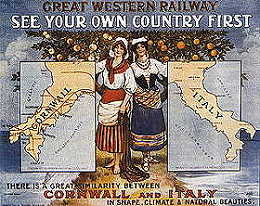 GWR's own film, The Story of the Holiday Line, was shown at the London Coliseum, while later, the company produced an annual publication called Holiday Haunts - listing the attractions of each resort covered by GWR lines.
GWR's own film, The Story of the Holiday Line, was shown at the London Coliseum, while later, the company produced an annual publication called Holiday Haunts - listing the attractions of each resort covered by GWR lines.
Like all railway companies at that time, the Great Western produced their own posters with many posters promoting travel to the Western coasts of Devon and Cornwall. As shown in the poster alongside, similarities between the holiday climates of Cornwall and Italy were given under the banner of 'See your own Country First'. Produced in the early 1920's, this poster formed part of a series showing similarities between the two 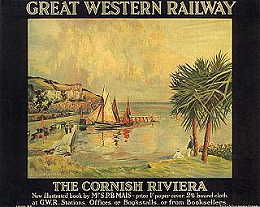 areas.
areas.
Similar to the Holiday Haunts series of publications, the GWR also produced several books on specific holiday destinations. This poster is shown to promote a new book by Mr. S. P. B. Mais entitled 'The Cornish Riviera', however, as well as promoting the book, as the Great Western's name is so prominent, passengers were drawn to the idea of travelling to Cornwall through the company's trains. It was produced by Louis Burleigh Bruhl in 1925, and he went on to make many fine paintings for the company.
One area that the Great Western managed to attract a lot of publicity was in the speed of their services, and one of the GWR expresses - the Cheltenham Flyer - was groomed to become 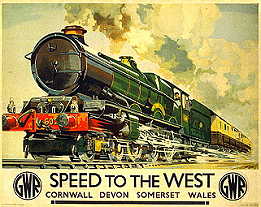 the fastest train the world. This amazing record was first achieved in 1929, with a booked average speed of 66.2mph from Swindon to Paddington. Maintaining this speed was easy on 'Brunel's Billiard Table' especially as 'Castle' class locomotives were employed for the 'Flyer'. However, in 1931, Canadian Pacific took the record for a few short months until the GWR raised the average speed to 69.2mph. A poster advertising the 'Cheltenham Flyer' service is show in the left-hand column, but as an extension of the speed theme, the artist Charles Mayo in 1939, produced one of the most popular Great Western posters of all time. Just for the record, on the
the fastest train the world. This amazing record was first achieved in 1929, with a booked average speed of 66.2mph from Swindon to Paddington. Maintaining this speed was easy on 'Brunel's Billiard Table' especially as 'Castle' class locomotives were employed for the 'Flyer'. However, in 1931, Canadian Pacific took the record for a few short months until the GWR raised the average speed to 69.2mph. A poster advertising the 'Cheltenham Flyer' service is show in the left-hand column, but as an extension of the speed theme, the artist Charles Mayo in 1939, produced one of the most popular Great Western posters of all time. Just for the record, on the 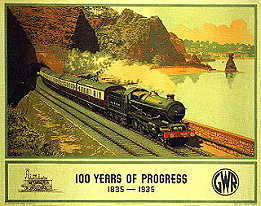 first day of the revised timetable for the 'Cheltenham Flyer', Launceston Castle was allowed to make a special attempt on the run from Swindon to Paddington and completed the journey at an average of 77.8mph. One year later, the booked speed was increased to 70mph, however, this was preceded by an all-out publicity run by Tregenna Castle, reaching Paddington in 56 minutes 47 seconds - an average of 81.7mph.
first day of the revised timetable for the 'Cheltenham Flyer', Launceston Castle was allowed to make a special attempt on the run from Swindon to Paddington and completed the journey at an average of 77.8mph. One year later, the booked speed was increased to 70mph, however, this was preceded by an all-out publicity run by Tregenna Castle, reaching Paddington in 56 minutes 47 seconds - an average of 81.7mph.
The final poster shown was produced to mark one hundred years of the Great Western Railway in 1935, showing a state of the art 'King' class locomotive. The artist was Murray Secretan.
In addition to the usual literature,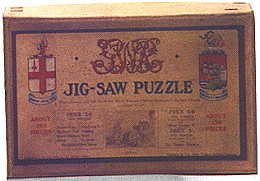 passengers could pass the hours with a Great Western jigsaw bought from a station bookstall. The first of the series of 44 jigsaws, was of 'Castle' class number 4073 Caerphilly Castle and this puzzle was produced in time for the British Empire Exhibition at Wembley in 1924 where the locomotive was on display. Initially, the 150 piece jigsaw was sold for 5 shillings (25p), but a month later the price was reduced to 2 shillings and 6 pence (12½p). This reduced price only just covered the cost of producing the jigsaw, but publicity rather than profit
passengers could pass the hours with a Great Western jigsaw bought from a station bookstall. The first of the series of 44 jigsaws, was of 'Castle' class number 4073 Caerphilly Castle and this puzzle was produced in time for the British Empire Exhibition at Wembley in 1924 where the locomotive was on display. Initially, the 150 piece jigsaw was sold for 5 shillings (25p), but a month later the price was reduced to 2 shillings and 6 pence (12½p). This reduced price only just covered the cost of producing the jigsaw, but publicity rather than profit 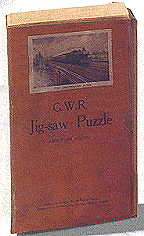 was the object of the exercise. This first puzzle was such a success that one American railroad owner remarked to James Ingliss, General Manager of the Great Western, "and people actually pay you for your publicity?"
was the object of the exercise. This first puzzle was such a success that one American railroad owner remarked to James Ingliss, General Manager of the Great Western, "and people actually pay you for your publicity?"
As the number of jigsaw puzzles increased so did the variety of the subjects covered from other GWR locomotives to Cathedrals, station buildings and castles. All but seven puzzles cost that same 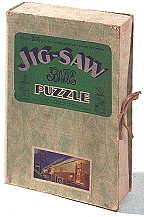 reduced price of 2 shillings and 6 pence (12½p) for 150 pieces, although those seven puzzles contained 375 to 400 pieces. Two particular favourites were the double-sided jigsaw of 1926 showing Exeter Cathedral on one side and a map of the Great Western system on the other, and a pair of puzzles in one box consisting two paintings by Frith of The Railway Station and the View of Paddington Station. There was also produced were three large piece puzzles for young children. The boxes containing the jigsaws also differed. The original puzzles were sold in boxes with lift-off lids, but in the early 1930's, the box changed to a book design.
reduced price of 2 shillings and 6 pence (12½p) for 150 pieces, although those seven puzzles contained 375 to 400 pieces. Two particular favourites were the double-sided jigsaw of 1926 showing Exeter Cathedral on one side and a map of the Great Western system on the other, and a pair of puzzles in one box consisting two paintings by Frith of The Railway Station and the View of Paddington Station. There was also produced were three large piece puzzles for young children. The boxes containing the jigsaws also differed. The original puzzles were sold in boxes with lift-off lids, but in the early 1930's, the box changed to a book design.
All of the million puzzles were manufactured for the Great Western in the 1920's and 30's by Chad Valley in Harborne, Birmingham, and although the company closed many years ago, if you are fortunate enough to own one of the puzzles, but it has a piece damaged, a specialist firm can manufacture a new piece.
The complete list of all known puzzles available are:
'Caerphilly Castle', 150 pieces. Issued 1924, withdrawn 1928.
'The Cathedral', 150 pieces. Issued 1926, withdrawn 1935.
'The Railway Station', 2 puzzles of 150 pieces each. Issued 1926, withdrawn 1929.
'Windsor Castle', 150 pieces. Issued 1926, withdrawn 1930.
'The St. Julien', 150 pieces. Issued 1926, withdrawn 1928.
'St. Julien', 150 pieces. Issued 1927, withdrawn 1931.
'King George V', 150 pieces. Issued 1927, withdrawn 1936.
'Cornish Riviera Express', 150 pieces. Issued 1927, withdrawn 1936.
'The Freight Train', 150 pieces. Issued 1927, withdrawn 1930.
'Speed', 150 pieces. Issued 1928, withdrawn 1930.
'Britain's Mightiest', 150 pieces. Issued 1927, withdrawn 1930.
'Oxford', 150 pieces. Issued 1927, withdrawn 1930.
'Swansea Docks', 150 pieces. Issued 1928, withdrawn 1932.
'Ann Hathaway's Cottage', 150 pieces. Issued 1930, withdrawn 1933.
'A Cornish Fishing Village', 150 pieces. Issued 1930, withdrawn 1933.
'Glorious Devon', 150 pieces. Issued 1930, withdrawn 1933.
'Springtime in Devon', 150 pieces. Issued 1930, withdrawn 1933.
'The Vikings Landing at St. Ives', originally 375 pieces increased to 400 pieces. Issued 1930, withdrawn 1936.
'St. David's Cathedral', 150 pieces. Issued 1930, withdrawn 1934.
'Warwick Castle', 150 pieces. Issued 1930, withdrawn 1933.
'The Torbay Express', 375 pieces. Issued 1930, withdrawn 1934.
'Mountains of Killarney', 150 pieces. Issued 1931, withdrawn 1935.
'Windsor Castle', 150 pieces. Issued 1931, withdrawn 1933.
'King Arthur on Dartmoor', 375 pieces later increased to 400 pieces. Issued 1931, withdrawn
1936.
'Bath', 150 pieces. Issued 1932, withdrawn 1936.
'Stratford on Avon', 375 pieces later increased to 400. Issued 1933, withdrawn 1938.
'The Cheltenham Flyer', 150 pieces later increased to 200. Issued 1933, withdrawn 1936.
'Henley Bridge', 200 pieces. Issued 1933, withdrawn 1935.
'Historic Totnes', 200 pieces later decreased to 150. Issued 1933, withdrawn 1939.
'Piccadilly Circus', 200 pieces. Issued 1933, withdrawn 1937.
'The Romans at Caerleon', 200 pieces later decreased to 150. Issued 1933, withdrawn 1939.
'The Royal Route to the West', 200 pieces later decreased to 150. Issued 1933, withdrawn 1939.
'Brazenose College, Oxford', 400 pieces. Issued 1933, withdrawn 1939.
'Locomotives Old and New', 200 pieces later decreased to 150. Issued 1934, withdrawn 1939.
'Drake Comes West', 400 pieces. Issued 1934, withdrawn 1939.
'The Night Mail', 200 pieces. Issued 1934, withdrawn 1936.
'The Model Railway', 200 pieces later decreased to 150. Issued 1935, withdrawn 1939.
'London Highways', 200 pieces. Issued 1935, withdrawn 1936.
'The Fishguard Army, 1797', 200 pieces later decreased to 150. Issued 1935, withdrawn 1939.
'The Streamlined Way', 200 pieces later decreased to 150. Issued 1935, withdrawn 1938.
'Windsor Castle from the Air', 200 pieces later decreased to 150. Issued 1937, withdrawn 1939.
'GWR Locomotives in the Making', 200 pieces later decreased to 150. Issued 1937, withdrawn 1939.
'Cornwall - Preparing for a Catch', 200 pieces later decreased to 150. Issued 1937, withdrawn 1939.
Knowing the value of publicity to the many increasing number of Great Western enthusiasts, the GWR produced a series of books for, to quote their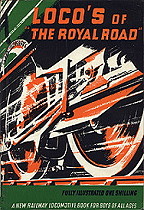 famous words, "Boys of all ages".
famous words, "Boys of all ages".
The man behind the series of books was Walter George Chapman, a member of the general manager's staff who joined the Great Western in 1896. While in the general manager's office, he wrote his first book, published in August 1923 called The 10.30 Limited describing 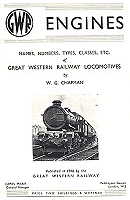 a non-stop run between Paddington and Plymouth on the Cornish Riviera Express, which sold for the modest sum of 5 shillings (25p). Understandably, sales of this book exceeded expectations, reaching 71,000 copies in the first six months. Another three books followed within a short space of time and these included Caerphilly Castle and The 'King' of Railway Locomotives, however, as in the case of the Great Western jigsaw puzzles, the price was reduced of the subsequent volumes to just one shilling (5p). These four books alone produced sales of 130,000 copies.
a non-stop run between Paddington and Plymouth on the Cornish Riviera Express, which sold for the modest sum of 5 shillings (25p). Understandably, sales of this book exceeded expectations, reaching 71,000 copies in the first six months. Another three books followed within a short space of time and these included Caerphilly Castle and The 'King' of Railway Locomotives, however, as in the case of the Great Western jigsaw puzzles, the price was reduced of the subsequent volumes to just one shilling (5p). These four books alone produced sales of 130,000 copies.
In 1929, W. G. Chapman was transferred to the Great Western publicity department, where he produced three more books, namely The Cheltenham Flyer, Track Topics and another of his best known books, Loco's of the 'Royal Road'. In addition, he also edited the 'bible' of the Great Western, GWR Engines; names, numbers, types & classes, usually referred to as the 'Engine Book'.
Fortunately, David & Charles Publishers of Newton Abbot have reprinted the last two books mentioned, namely Loco's of the Royal Road and GWR Engines; names, numbers, types and classes, so that other 'Boys of all ages' may gain more enjoyment of the Great Western Railway.
Return to top of page
Copyright © by John Daniel 2013.
